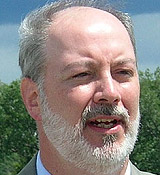
Significant Milestones in the Fight Against Climate Change
Monday, June 22, 2015
By: John F. Sheehan - Adirondack Council Communications Director

I am very excited that June has already marked some significant milestones in the struggle to control global climate change, which threatens the clean water, healthy forests and vibrant communities of the Adirondack Park. This week could bring another.
On June 15 and 16, dozens of people gathered for an intensive two-day meeting in Chestertown to discuss how Adirondack residents can cope with inevitable changes in temperature over the next 25 years, while doing what we can to anticipate and blunt those impacts here.
On June 18, Roman Catholic Pope Francis issued a statement calling for action to reduce greenhouse gas emissions worldwide. And this week, the U.S. House of Representatives is expected to vote on a bill designed to gut President Barack Obama’s plan to cut carbon emissions from the smokestacks of the nation’s existing power plants.
In-Park Conference
Chestertown was an excellent choice for the two-day, in-Park climate conference. The town’s Supervisor, Fred Monroe, has been a leader in tapping sunlight to generate power for the town’s municipal buildings. Conference participants passed one of Chestertown’s large solar power arrays on the way to the conference at town hall, near the intersection of Route 8 and Route 9.
Participants were asked how we should respond locally to globally generated climate threats. More than 40 people from various backgrounds were sorted into teams that tried to determine the best strategies for addressing climate threats, while also using scientific methods to predict the most likely outcomes.
The agenda was set by Jim Herman and Dave Mason of Keene Valley, whose “Adirondack Futures” conference series helped to determine that everyone from property rights advocates to local government to environmental organizations all wanted the Park to remain green, wild and healthy, with a sustainable economy. Their new project will be replicated around the Park with fresh participants. Later, they hope to adapt the program for other parts of the United States and the world and take it on tour in the near future.
Dave and Jim plan to offer a four-hour version of this conference for those who cannot manage two days off from work or school to participate. Those who want to participate can contact Jim Herman at jim12942@gmail.com.
At the conference, I was lucky enough to be on a team consisting of a state environmental official, a forestry professor, two college Adirondack program directors, and a professional planner. We were asked to assess how Adirondack communities might make themselves more resilient to climate change and what must happen over the next 25 years to make that possible. In short, we opted to take the same approach St. Francis of Assisi advocated. We accepted those things we cannot change, while endeavoring to change those things we can (and hoped we understood the difference).
Of course, I am partial to St. Francis. He is the patron saint of environmental activists. I was born on Oct. 4, which is his feast day in the Roman Catholic calendar. I took Francis as my middle name at confirmation – long before I imagined a career in environmental protection was even possible. So you can imagine my delight when the new Pope took his name too and adopted his philosophy toward environmental protection.
The Pope's Message
Pope Francis last week made good on his promise to speak out about climate change and its impact on the natural world and the poor. His message was meant as a reminder to everyone that human beings have the honor of being stewards of the earth, but that this honor comes with a responsibility to protect nature, ourselves, the poor, and future generations from rapid, severe and unpredictable changes in the planet’s life-support systems.
The Pope’s actions are a vitally important counterpoint to the disinformation campaign being carried on by climate change deniers who hope to forestall action on curbing the use of coal and other fossil fuels. His message is especially important in New York State, where one third of our residents (7-million people) identify themselves as Catholic.
The Vote in Congress
In addition, this week, the U.S. House of Representatives plans to debate a bill aimed at preventing the U.S. Environmental Protection Agency (EPA) from implementing the Clean Power Plan. The plan would require cuts in greenhouse gas emissions from existing power plants nationwide.
In order to make compliance easier, the EPA has asked state officials to develop their own plans for carbon emissions reductions, based on each state’s unique power grid and fleet of existing plants. However, Senate Majority Leader Mitch McConnell, R-Kentucky, has advised states to ignore the EPA’s request for state implementation plans, saying it would be easier to delay or halt emissions reductions if states don’t cooperate.
On June 24, the House is expected to vote on a bill (H.R.2042) that would let states opt-out of the EPA’s plan and also indefinitely delay the plan’s implementation. Adirondack Council members and friends of the Park have written to the state’s Congressional delegation and other Congressional leaders urging them to vote against the bill.
McConnell and other opponents fear that power plants will be forced to burn less coal in order to comply with adequate greenhouse gas standards. Less coal use would be very good for the Adirondack Park. Coal’s high carbon content contributes to climate change, but coal also contains other pollutants that cause acid rain.
New York has made steady progress on curbing acid rain and reducing coal use since passing the nation’s first acid rain law in 1984. Coal now accounts for very little of New York’s domestic power production and New York emissions account for very little of the acid rain hitting the Adirondacks. Today, more than three-quarters of the sulfur dioxide and nitrogen oxides causing acid rain in the Adirondack Park come from outside New York.
In 2014, our neighbors in Ontario, who had been a significant nearby source of acid rain, stopped burning coal to make electricity. So our sources of greatest concern are in the American Midwest and South – including Kentucky -- where coal is still the main source of power plant fuel.
Keep your eyes peeled for news on U.S. Congressional action during the week.
|
Would you like to comment on what you've read or viewed? We'd love to hear from you. Please click to send us a message.
Born and raised in Troy, NY, John Sheehan is a graduate of Catholic Central High School and the State University at Albany (1985; BA). Before joining the Council's staff in 1990, John was the managing editor of the Malone Evening Telegram, just north of the Adirondack Park. Prior to that, he worked as journalist for the Troy Record, (Schenectady) Daily Gazette, Watertown Daily Times and Newsday. John is a regular guest lecturer at several New York colleges and universities, including Colgate University, Hobart & William Smith College, Hamilton College, Rensselaer Polytechnic Institute, Union College, Siena College, SUNY Albany, SUNY Binghamton, SUNY College of Environmental Science and Forestry (Syracuse), and SUNY Potsdam. He has also addressed dozens of local organizations including local Rotary and Kiwanis clubs and chambers of commerce, scientific societies and community forums. John and his wife Deborah live in Albany and are seasonal residents of the Adirondack Park. Their daughter Hannah attends Albany public schools. |
||





